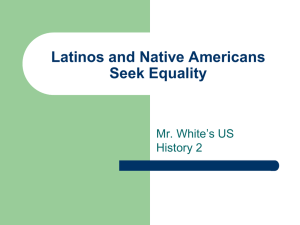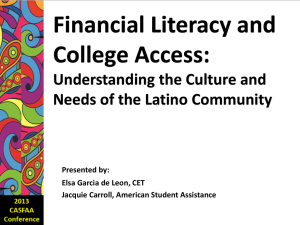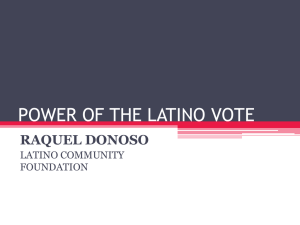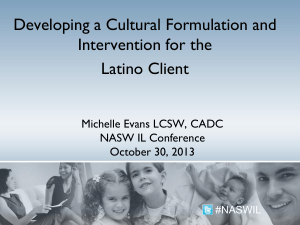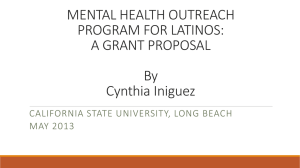Latino – counseling
advertisement
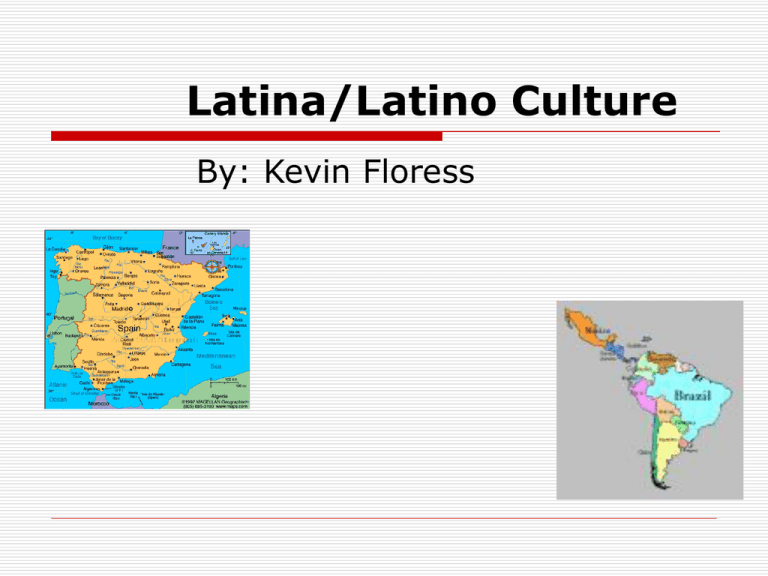
Latina/Latino Culture By: Kevin Floress Overview The Latino Population Difficulties for Latinos Latinos Underrepresented/served Culture & Counseling Implications Activity The Latino Population: “Latino” vs. “Hispanic” HISPANIC derives from the mostly white Iberian Peninsula that includes Spain and Portugal LATINO derives from the indigenous people of the Americas (Mexico, Central America, and South America). “Latino” not included in U.S. Census Bureau until 2000! Now - “Hispanic or Latino of any race.” The Latino Population: “Latino” vs. “Hispanic” One study: 1200 registered voters Older and liberal prefer Latino Assimilated, conservative, young prefer Hispanic Hispanic and Latino, often used interchangeably. While some resent the interchangeable use of the terms, together, they represent a diverse group of individuals who share many things in common such as language, religion, and customs. Insert country name: _______American No definitive answer = preference! The Latino Population: Fastest Growing Population In 1990 Latino population = 22.4 million In 2000 Latino population = 35.3 million = increase of nearly 58% in 10 years!!! Total U.S. population (2000) = 281.4 million 35.3 million Latinos represent 12.5% of population = For first time, Latinos represent largest minority group in U.S. The Latino Population: Fastest Growing Population According to American Community Survey by U.S. Census Bureau: 2004 Latino population = 40.5million; representing 14.2% of U.S. population (nearly 2% increase in only 4 years!) Projection: By the year 2050, 1 of 4 American residents will be of Latino descent!! The Latino Population: Diverse group More than 20 different countries Varying socio-cultural backgrounds Several different Spanish dialects 72% 1st generation Latinos speak Spanish 78% 3rd generation older speak English as primary = Don’t assume b/c client has Latino sounding surname they speak Spanish! The Latino Population: Diverse group 58.5% Mexico 9.6% Puerto Rico 4.8% Central America 3.8% South America 3.5% Cuba 2.2% Dominican Republic .3% Spain Remaining 17.3% = “all other” The Latino Population: Where are Latinos in U.S.? 75% in South and Western U.S. 15% in Midwest 9% in Northeast 77% of population in just 7 states: CA, TX, NY, FL, IL, AZ, NJ The Latino Population: Where are Latinos in U.S.? California = highest population (11 million) Texas = 2nd highest (6.7 million) New Mexico = highest proportion (42% of residents) Overview: The Latino Population Difficulties for Latinos Latinos Underrepresented/served Culture & Counseling Implications Activity Difficulties for Latinos U.S. attributes for individual success Power inequities Racial profiling Difficulties for Latinos: U.S. Attributes for Individual Success: “Self-Determination” + “Hard Work” = Success “Lazy”+ “Incompetent” = Not Successful Reality = Unequal opportunities based on gender, race-skin color, national origin, 1st language, socioeconomic class, age, sexual orientation, etc…… Difficulties for Latinos: Power Inequities Unequal distribution of political, economic, social, symbolic power in U.S. Unequal distribution of opportunities among varying ethnic & cultural groups. Alienation (Torres, 2004) Difficulties for Latinos: Power Inequities Furthermore, Latinas (Latino women), earn only 52% of equally educated white males in FT, permanent positions. Still far below the 72% Caucasian females earn. (Torres, 2004) Difficulties for Latinos: Racial Profiling Latinos not race; however, profiling exists According to Aguirre, author of “Profiling Mexican American Identity:” During traffic stops, Latinos motorists 11% probability of vehicle search; Caucasians 5% Latinos 8% probability of physical search; Caucasians 4% Latinos more likely to be victims of police physical violence Overview The Latino Population Difficulties for Latinos Latinos Underrepresented/served Culture & Counseling Implications Activity Latinos Underrepresented & Underserved Education Popular Media Political Domain Business World Latinos Underrepresented: Education Latinos most undereducated population in U.S. In 2001, Latino immigrant HS dropout rate = 44.2% (7.4 % for all others combined) First generation dropout rate 14.6% Around 15% for later generations (Mehring, 2005) Latinos Underrepresented: Education % of Latino population graduating from college alarmingly low! Reasons for dropouts = language barriers + attending lower quality inner city schools Need to create more English language programs that don’t interfere w/ reg. class (Mehring, 2005) Latinos Underrepresented: Popular Media Latinos over 12.5% of U.S. population Latinos represent only 1-3% of primetime television actors/actresses Portrayed narrowly and often negatively: - Criminals, law enforcers, Latin lovers, harlots or prostitutes, or comic relief. (Mastrow & Morawitz, 2005) Latinos Underrepresented: Political Domain As of 2005, very few Latino politicians While mayor of Los Angeles and governor of New Mexico are both Latino, the total number of Latino politicians can be counted w/2 hands with fingers to spare. (Roncevic, 2005) Latinos Underrepresented: Business World Very few Latinos in professional business sector. Few small business owners, fewer heads of major corps. Correlation with lack of education Extremely important! As Latino success becomes increasingly important for U.S. economic success. Overview The Latino Population Difficulties for Latinos Latinos Underrepresented/served Culture & Counseling Implications Activity Traditional Latino Culture and Implications for Counseling Traditional beliefs Familismo Personalismo Gender Roles Trad’l Latino Culture & Counseling: 7 Traditional Latino beliefs (text book, p.174) 1. Strict/separate roles for male-female 2. Strong family/community identity 3. Past/present time orientation vs. future 4. Value elderly over youth 5. Value traditions & rituals 6. Respect authority 7. Value spirituality Trad’l Latino Culture & Counseling: Familismo? Faithfulness, loyalty reciprocity, and unity within immediate and extended family Family needs greater than individuals! Varies greatly from dominant culture where autonomy is highly valued! Trad’l Latino Culture & Counseling: Familismo impact on counseling What are possible implications for counseling? Decision making can be difficult (may need family involvement) Ask client preferred communication (designated family member?) Multiple people may come to the counseling session May affect limits of confidentiality & change interventions e.g. need to collaborate w/family members prior to treatment decisions Perhaps enroll family member assistance in intervention plans Trad’l Latino Culture & Counseling: Personalismo? Intimate, personal, respectful relationships Interactions should be warm, friendly, and personal Interpersonal relationships more highly valued than task achievement Trad’l Latino Culture & Counseling: Personalismo impact on counseling What are possible implications for counseling? Spend increased time/effort in initial stages: Building rapport & Therapeutic alliance Rogerian skills: Display empathy, warmth, attentive listening, genuineness, etc. Possibly increase self disclosures so client sees personal side trust & compliance greater likelihood of positive counseling outcome Would you accept personal invitation from Latino client? Trad’l Latino Culture & Counseling: Gender Roles - Male Machismo – promotion of traditional male/female roles Males (possible pros/cons) Stereotypical Pros: work hard, protect, make important decisions, and provide financially for family Stereotypical Cons: Heavy drinking (manly to “hold you liquor”), risk taking, highly authoritarian, physical violence Trad’l Latino Culture & Counseling: Gender Role – Female Woman’s status correlate w/ability to bear children Taking care of the family Good wife cooks, cleans, and takes care of children Stands behind husband’s decisions Trad’l Latino Culture & Counseling: Gender Role impact in counseling What are possible implications for counseling? Recognize client’s contextual perspective of male-female relations Refrain from forcing Anglo-American values onto client May affect diagnosis of client: (e.g. Latina that seems passive may not be passive by her culture’s standards) Summary The Latino Population Difficulties for Latinos Latinos Underrepresented/served Culture & Counseling Implications ---> Activity Activity: Break into groups (3 - 4members) Scenarios: You are a community counselor: Case conceptualization: How would you approach and what would you consider for the following cases? Scenarios 1. Unmarried, 3rd generation Latina. Presenting issue: Lacks assertiveness 2. Married, Latino male. Has been in U.S. for 3 years. Presenting issue: Court ordered alcohol treatment 3. Married, 1st generation Latina. Presenting issue: Trust issues. 4. Unmarried, 2nd generation, Latino male. Presenting issue: Anger control 5. Unmarried, newly immigrated Latina. Presenting issue: Depression

